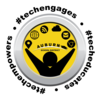Technology Cleaning Instructions
Preparations
You will need the following items:
Isopropyl alcohol (70%) (Do not use cleaning wipes/packets as they are too wet.)
Cleaning cloths as specified below
Screen cleaning product
These cleaning items should be stored away from students. Use sanitary non-latex gloves if cleaning large quantities requiring sustained contact with alcohol-based products.
Step 1: Completely power down the device.
For Chromebooks, turn it off by holding down the power button in the top right corner or left edge. Don’t set it to sleep or hibernate. Shut it off completely and make sure it’s off.
For a desktop PC, turn it off by choosing the “Windows” icon and selecting “Shut down” from the menu. Shut it off completely and make sure it’s off.
Step 2: Remove any connected peripherals from mobile devices (Chromebooks, Tablets,
iPads, etc.). This includes USB devices such as a mouse, keyboard, USB drive, external hard drive, power cable, etc. Make sure there is nothing still connected to a mobile device to be cleaned.
Cleaning the Keyboard
Step 1: Apply a teaspoon of isopropyl alcohol on a semi-abrasive cloth.
Use a terry cloth or microfiber towel; paper towels should not be used for this purpose.
Step 2: Slowly, but firmly, go over your keys in a circular motion per key.
Apply more isopropyl alcohol as needed. Don’t worry about the alcohol getting in between keys too much. It’s not harmful to electronics by nature, but do not spray liquid directly onto the device.
Step 3: After all the keys are cleaned, let the device sit until completely dry.
This should only take a few minutes as rubbing alcohol evaporates quickly at room temperature.
Cleaning other Peripherals
Headsets used for ELPA testing should be cleaned between testings.
Step 1: Apply a teaspoon of isopropyl alcohol on a semi-abrasive cloth.
Use a terry cloth or microfiber towel; paper towels should not be used for this purpose.
Step 2: Slowly go over exposed areas in a circular motion (i.e. microphone on a headset, earbuds/cords on headphones).
Apply more isopropyl alcohol as needed. Alcohol is not harmful to electronics by nature, but do not spray liquid directly onto peripherals.
Step 3: Let the item sit until completely dry.
This should only take a few minutes as rubbing alcohol evaporates quickly at room temperature.
Cleaning the Trackpad, Lid, and/or Body of a Mobile or PC Device
Step 1: Apply a teaspoon of isopropyl alcohol to terry cloth or microfiber towel.
Step 2: Wipe gently, but firmly, in a circular motion along the surface.
Step 3: Let it air dry. No need to wipe. The solution will evaporate by itself and should leave no residue. If any residue remains, simply wipe it off with a cloth.
Cleaning the Screen
All-in-one solutions generic cleaners are not safe for your display and may leave streaks or damage. Do not use normal soap, glass cleaner, or isopropyl alcohol to clean a screen. The following specialized cleaners are recommended:
Follow the manufacturer’s directions to ensure that you clean the screen safely using a microfiber cloth.
For assistance disinfecting a device screen, contact your school BTC/TSS to complete this gentle process. (Do not transport devices for cleaning.)
Cleaning Ports on a Device - USB, Power, Headphone, and Other Ports (BTCs/TSSes only)
Step 1: Use isopropyl alcohol on a non-abrasive cloth.
A microfiber or other non-abrasive cloth with just a dab so it’s just damp.
Step 2: Spray the port with compressed air.
Particles of dirt should be expelled in the process.
Step 3: Use the damp cloth and wipe the port after you spray it with the compressed air.
This will pick up any loose particles hanging on the edge of the port. Don’t stick the cloth into the port. The moisture can damage the port.
Step 4: Let the ports air dry.
Don’t use them or insert anything until it’s completely dry. The solution will evaporate by itself after a minute.
Adapted from: https://platypusplatypus.com/chromebooks/complete-guide-cleaning-chromebook/
